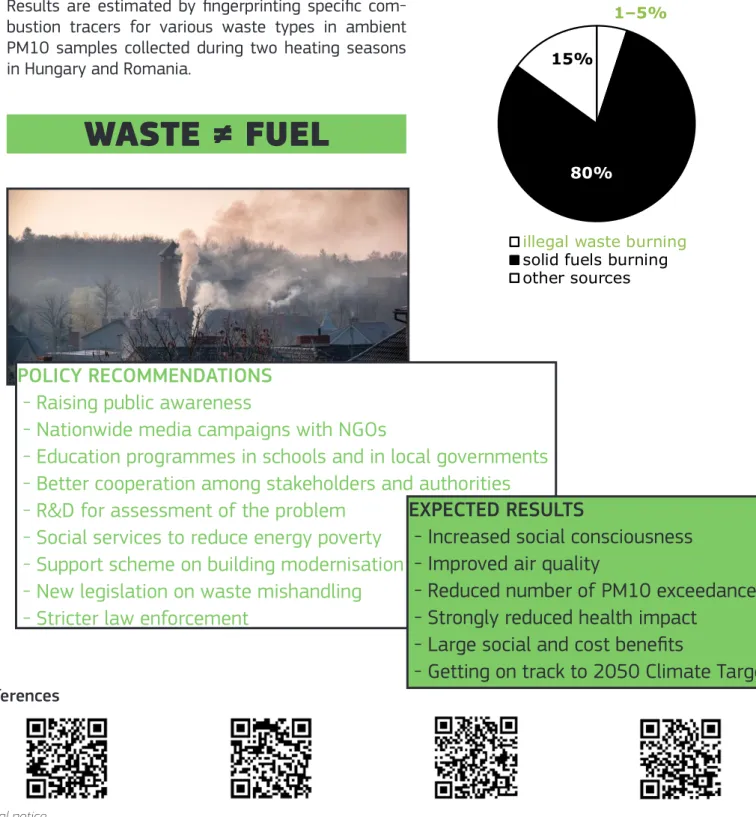Results are estimated by fingerprinting specific com- bustion tracers for various waste types in ambient PM10 samples collected during two heating seasons in Hungary and Romania.
WASTE ≠ FUEL
POLICY RECOMMENDATIONS - Raising public awareness
- Nationwide media campaigns with NGOs
- Education programmes in schools and in local governments - Better cooperation among stakeholders and authorities - R&D for assessment of the problem
- Social services to reduce energy poverty - Support scheme on building modernisation - New legislation on waste mishandling - Stricter law enforcement
EXPECTED RESULTS
- Increased social consciousness - Improved air quality
- Reduced number of PM10 exceedances - Strongly reduced health impact
- Large social and cost benefits
- Getting on track to 2050 Climate Target
The information and views set out in this leaflet are those of the author(s) and do not necessarily reflect the official opinion of the Commission.
The Commission does not guarantee the accuracy of the data included in this leaflet which comes from the final report of a study entitled
„Analysing the effect of residential solid waste burning on ambient air quality in Central and Eastern Europe and potential mitigations mea- sures” under service contract ENV 07.027727/2018/788206/SER/ENV.C3. Neither the Commision nor any person acting on the Commission’s behalf may be made of the information contained therein.
References
Legal notice
1–5%
80%
15%
illegal waste burning solid fuels burning other sources
FIGURE 3: THE CONTRIBUTION OF ILLEGAL WASTE BURNING TO PM10
(Source: Hoffer et al., 2021, https://doi.org/10.5194/acp-2021-585)
https://doi.org/10.14755/PE.2021.800 University of Pannonia, 2021.
Title: Noxious waste burning in Europe. The effects of residential solid waste burning on ambient air quality Authors: Beatrix Jancsek-Turóczi, András Hoffer, László Bozó, Luminita Marmureanu, Peter Viaene, Christof Asbach, András Gelencsér
NOXIOUS WASTE BURNING IN EUROPE
The effects of residential solid waste burning on ambient air quality
The contribution of residential heating to PM10 levels is significant in Central and Eastern Europe in winter, which is exacerbated by the uncontrolled burning of various types of solid wastes. A new study revealed that this illegal activity severely impairs air quality and endangers public health.
FIGURE 1: WASTE BURNING PRACTICES IN HUNGARY
(Source: Kantar Hoffmann Ltd. survey, 2017)
Regarding the fraction of the population: Regarding the typical waste types burned:
garden waste
22 %
household waste
13 %
treated wood
6 % textiles
6 %
plastics 3 %
tires 2 %
usedoil 1 %
Major motivations include poverty, ignorance, lack of knowledge, and irresponsibility.
Illegal waste burning poses a serious hazard to human health because:
- it releases 5-40 times more PM10 than wood burning;
- it releases 60-750 times more polycyclic aromatic hydrocarbons (PAHs) than wood burning;
- its emissions are up to 4,000 times more toxic than that of wood burning.
FIGURE 2: RELATIVE HEALTH HAZARDS BY WASTE TYPES
(Source: Hoffer et al., 2020, https://doi.org/10.5194/acp-20-16135-2020)
#CleanAirEU
#freeAIR
in stoves open burning
always often sometimes never 23%
26%
Environment

